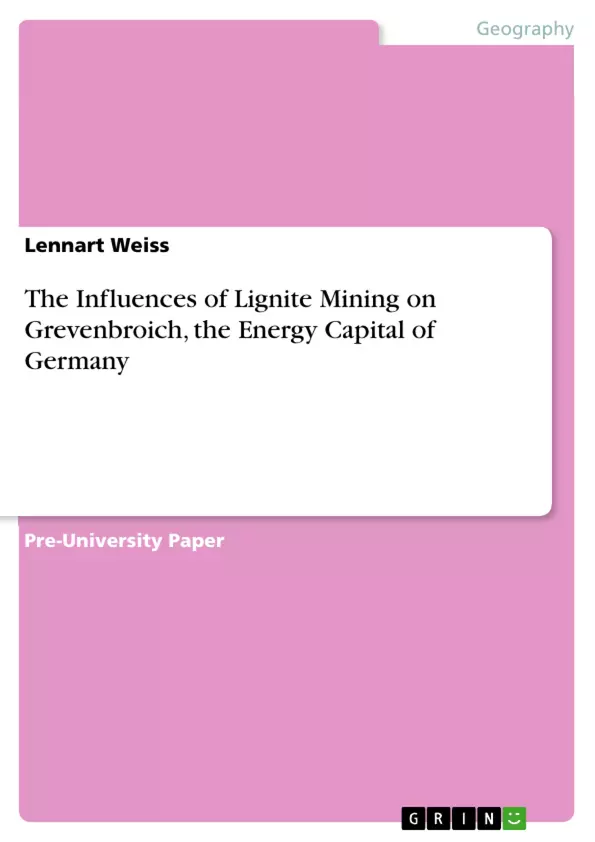As an inhabitant of Grevenbroich, I am personally interested in the influence of lignite mining on my home town, which I am going to focus on in this research paper. For this purpose, the topic is essentially divided into two main parts.
At first, I am going to portray the social development having taken place consistent with the different phases of valorisation of Grevenbroich’s mines, from the very first excavation to modern times. Naturally, the changing situation of Grevenbroich’s population has entailed drastic demographic changes as well.
However, it is essential to take the huge ecological impact of brown coal extraction into consideration in order to gain a complete impression. Hereby, it has to be differentiated between the aquatic ecosystems and those ashore.
Weighing these social and ecological effects, one can finally draw a conclusion of the influence of lignite mining on Grevenbroich, the energy capital of Germany.
Inhaltsverzeichnis (Table of Contents)
- 1. INTRODUCTION.
- 2. SOCIAL DEVELOPMENT - THE PHASES OF VALORISATION
- 2.1 Small-scale mining
- 2.2 Pre-Industrial Exploitation
- 2.3 Intensive mining in the course of Industrialisation and its aftermath.
- 2.4 Opencast mining in post-industrial times......
- 2.5 Demographic Development .......
- 3.ECOLOGICAL IMPACT
- 3.1 Landscape.
- 3.2 The Land Area's Ecosystem
- 3.2.1 Recultivation of the Land Area
- 3.3 Water Management and its Influence........
- 3.4 Recultivation of the Aquatic Ecosystem
- 3.5 Concluding Examination of Recultivation........
- 3.6 Air Pollution
- 4. CONCLUSION
Zielsetzung und Themenschwerpunkte (Objectives and Key Themes)
This research paper aims to explore the influence of lignite mining on the social and ecological development of Grevenbroich, Germany. The paper examines how the town's close connection to lignite mining has shaped its growth and identity.
- The social development of Grevenbroich in relation to the different phases of lignite mining, including small-scale mining, pre-industrial exploitation, intensive mining, and opencast mining.
- The impact of lignite mining on the ecological environment, encompassing landscape changes, ecosystem disruption, and the challenges of recultivation.
- The demographic changes experienced by Grevenbroich due to the presence of lignite mining.
- The overall influence of lignite mining on Grevenbroich, considering both social and ecological factors.
Zusammenfassung der Kapitel (Chapter Summaries)
Chapter 1 introduces the topic of lignite mining in Grevenbroich, exploring the city's self-proclaimed title as the "energy capital of Germany" and the relationship between lignite mining and the town's identity. The chapter also outlines the two main sections of the paper: social development and ecological impact.
Chapter 2 delves into the social development of Grevenbroich, analyzing the different phases of lignite mining and their influence on the city's economic, demographic, and urban growth. Chapter 2.1 explores the early stages of small-scale mining, dating back to Roman times. Chapter 2.2 examines the pre-industrial exploitation of peat and its impact on Grevenbroich's finances.
Schlüsselwörter (Keywords)
Lignite mining, Grevenbroich, Germany, social development, ecological impact, recultivation, industrialization, demographic change, energy capital, brown coal, environmental pollution, water management, ecosystem, landscape change.
- Arbeit zitieren
- Lennart Weiss (Autor:in), 2019, The Influences of Lignite Mining on Grevenbroich, the Energy Capital of Germany, München, GRIN Verlag, https://www.grin.com/document/465169



